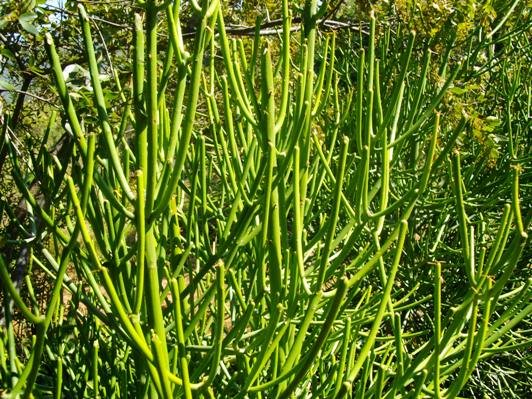Euphorbia tirucalli

Author: Ivan Lätti
Photographer: Ivan Lätti
Euphorbia tirucalli, commonly the rubber-hedge euphorbia and in Afrikaans the kraalnaboom (the kraal euphorbia), grows variably branched from 3 m to 5 m in height, sometimes reaching 10 m (SA Tree List No. 355).
Many erect, cylindrical, green stems show lots of smooth green surfaces. The succulent stems become from 5 mm to 8 mm in diameter. Hardly any of the small, slender leaves that normally drop off early can be seen here.
In South Africa the species distribution is in the east of the country, from the Eastern Cape and KwaZulu-Natal to the Mpumalanga Lowveld, the north of Gauteng and widespread in Limpopo, then widespread in tropical Africa.
The habitat is widely variable, including bushveld, rocky outcrops in mild climates. The species is not considered threatened in habitat early in the twenty first century.
E. tirucalli was exported by early seafarers to India and the Far East, where it flourished, adapting easily to a wide range of conditions. Entrepreneurial dreams of growing this plant for extracting firstly rubber and later biofuel have so far come to nothing, yielding only the need for and some interest in further research. Abandoned plantations of E. tirucalli are still to be seen in semi-arid regions, for instance in north-western Kenya on land that could probably not yield viable food crops anyway.
Medicinally the plant has been and may still be of interest in treating poisoning and venereal disease. The white latex from plant parts may cause blindness or blisters and ingesting plant parts may have caused fatalities. The plant has served as insecticide and as fish poison. Belief systems brought the plant some applications like keeping moles, rhinos and mosquitoes away.
Still, the plant appeals to gardeners, particularly the form that produces yellow and bronze-coloured stems. It can also be grown into an attractive hedge and even a kraal for livestock, as the kraalnaboom name indicates (Smith, et al, 2017; Coates Palgrave, 2002; Schmidt, et al, 2002; iNaturalist; Wikipedia; http://redlist.sanbi.org).

